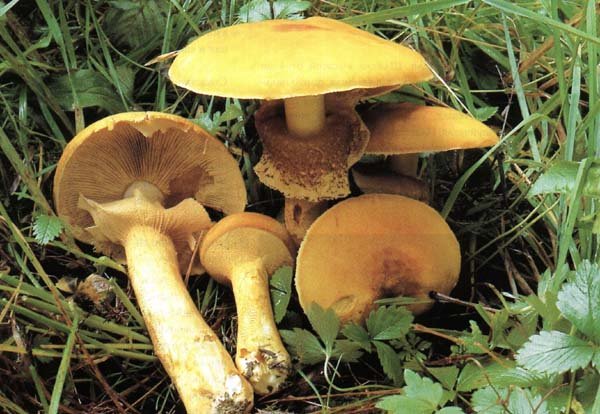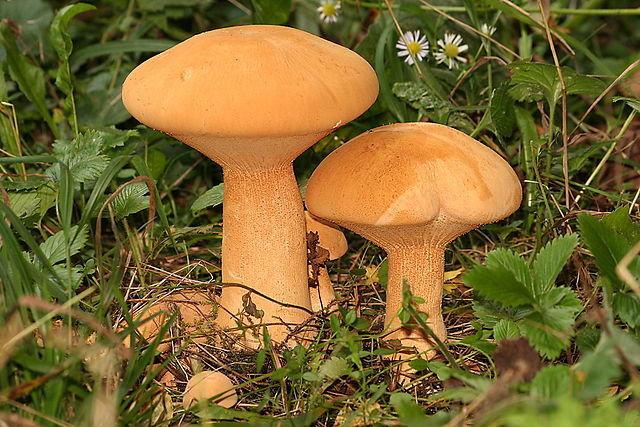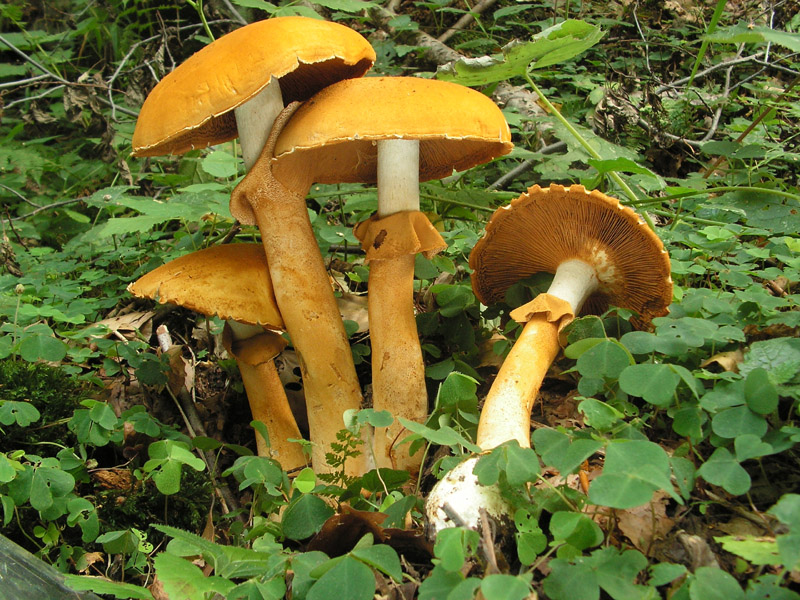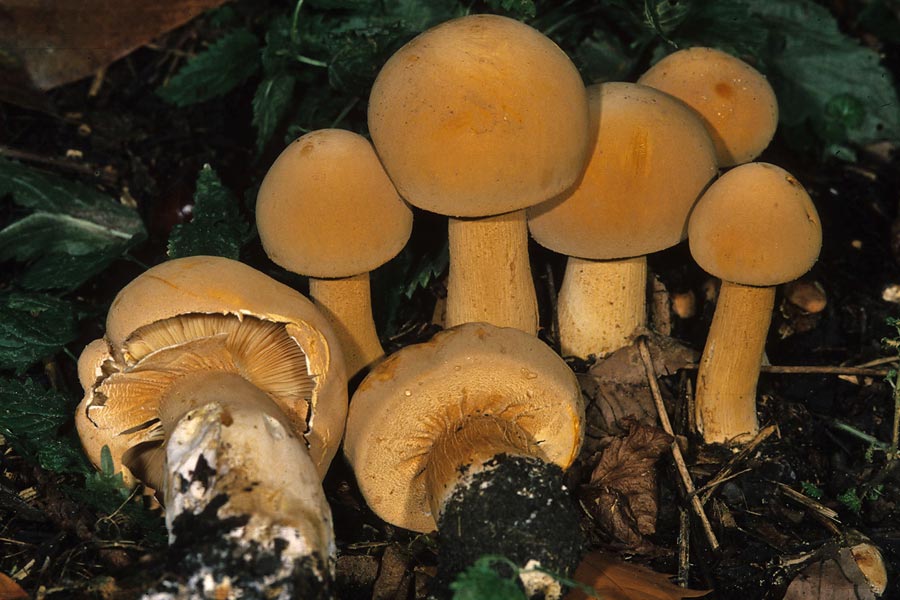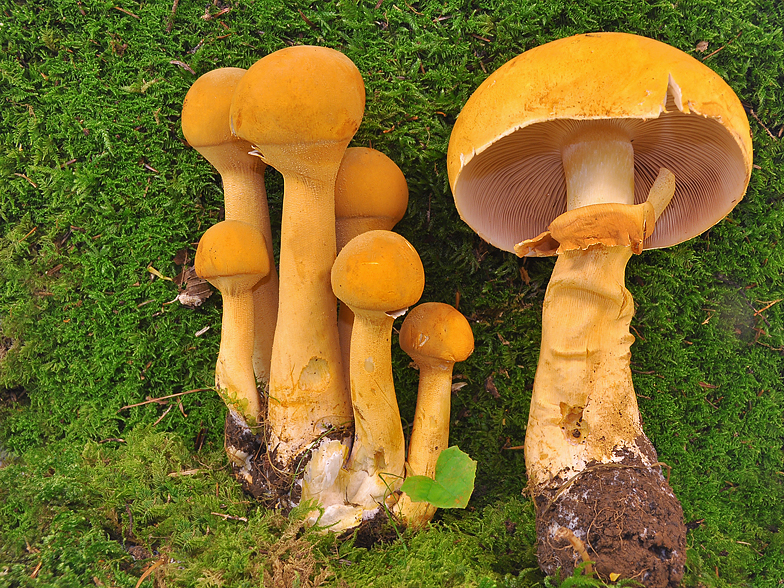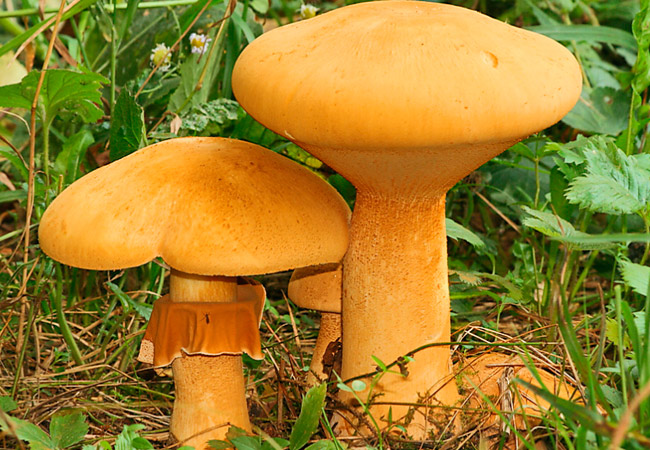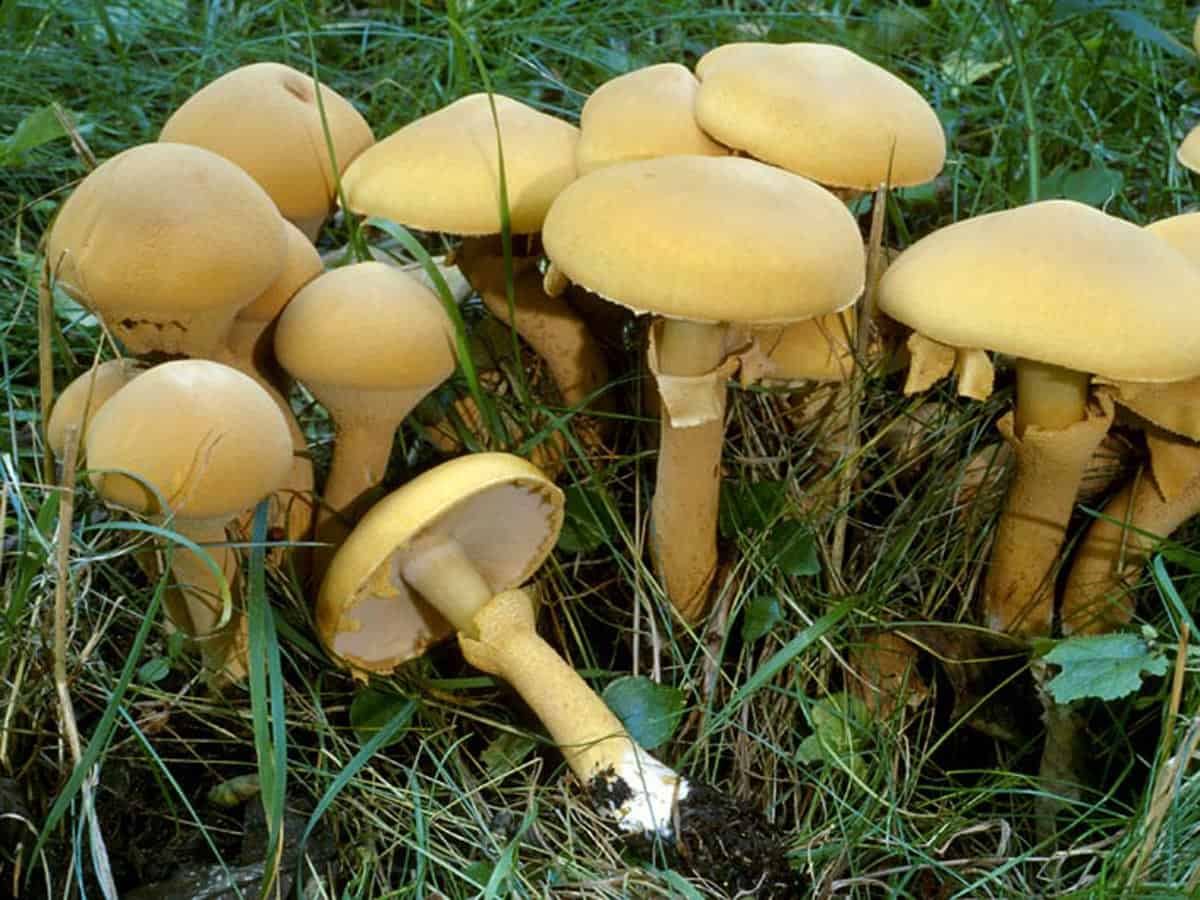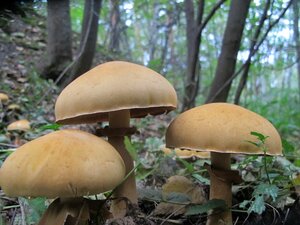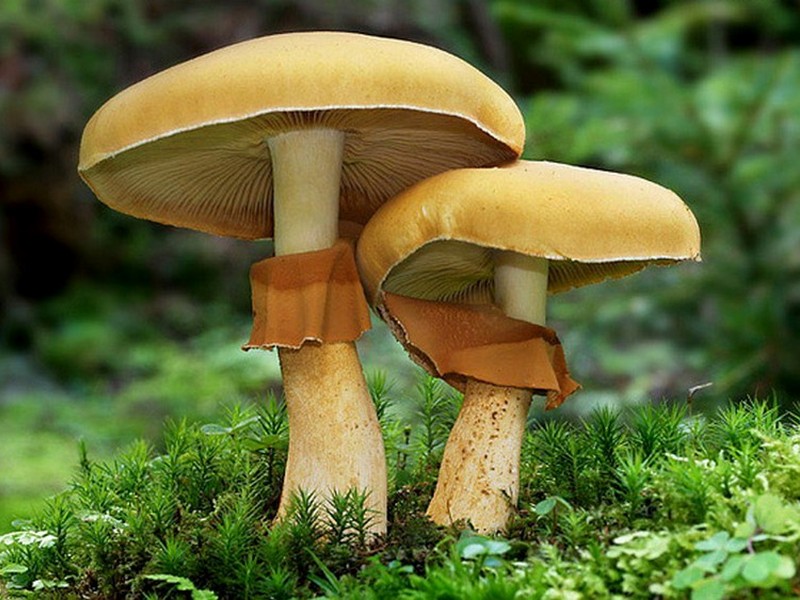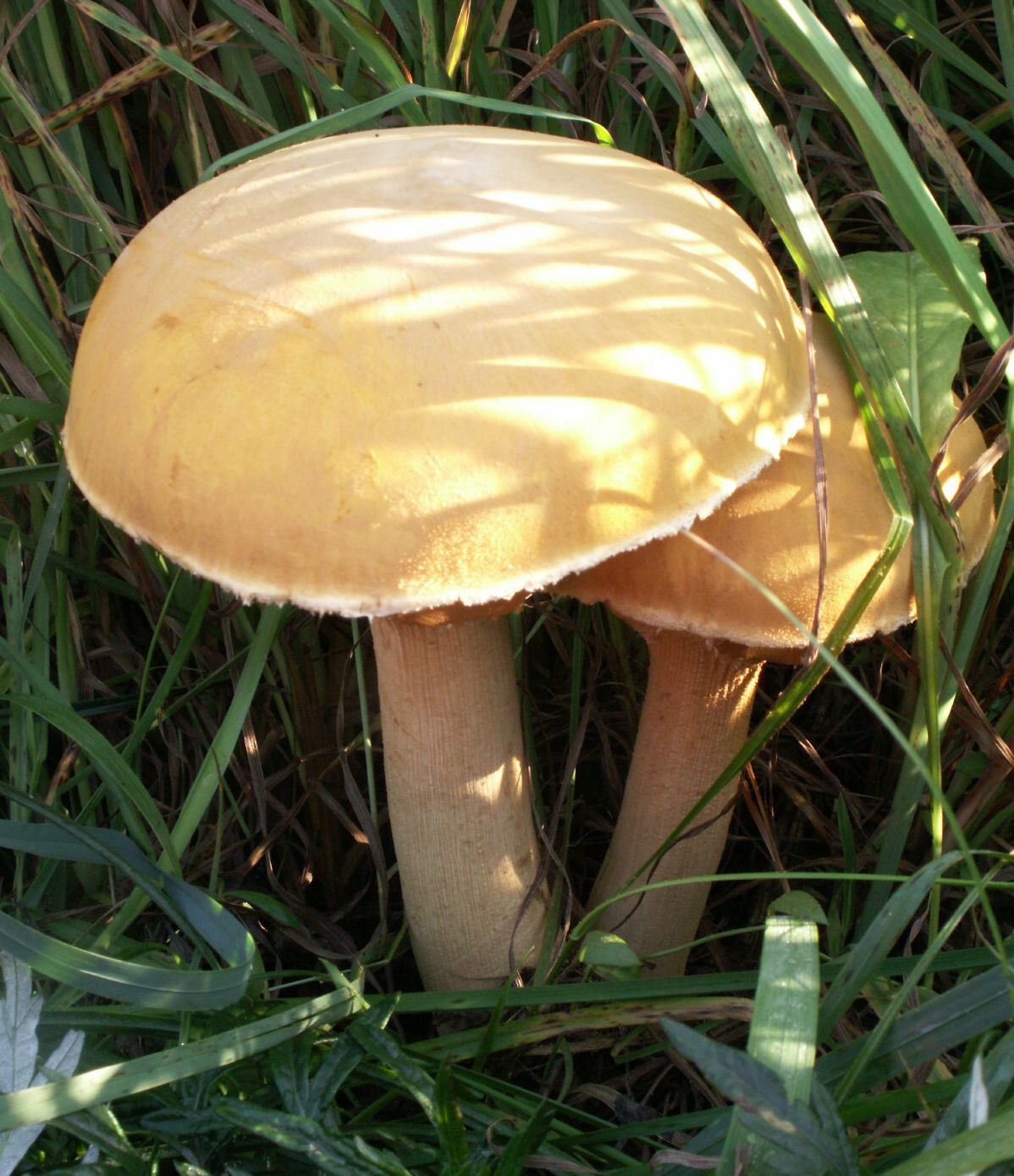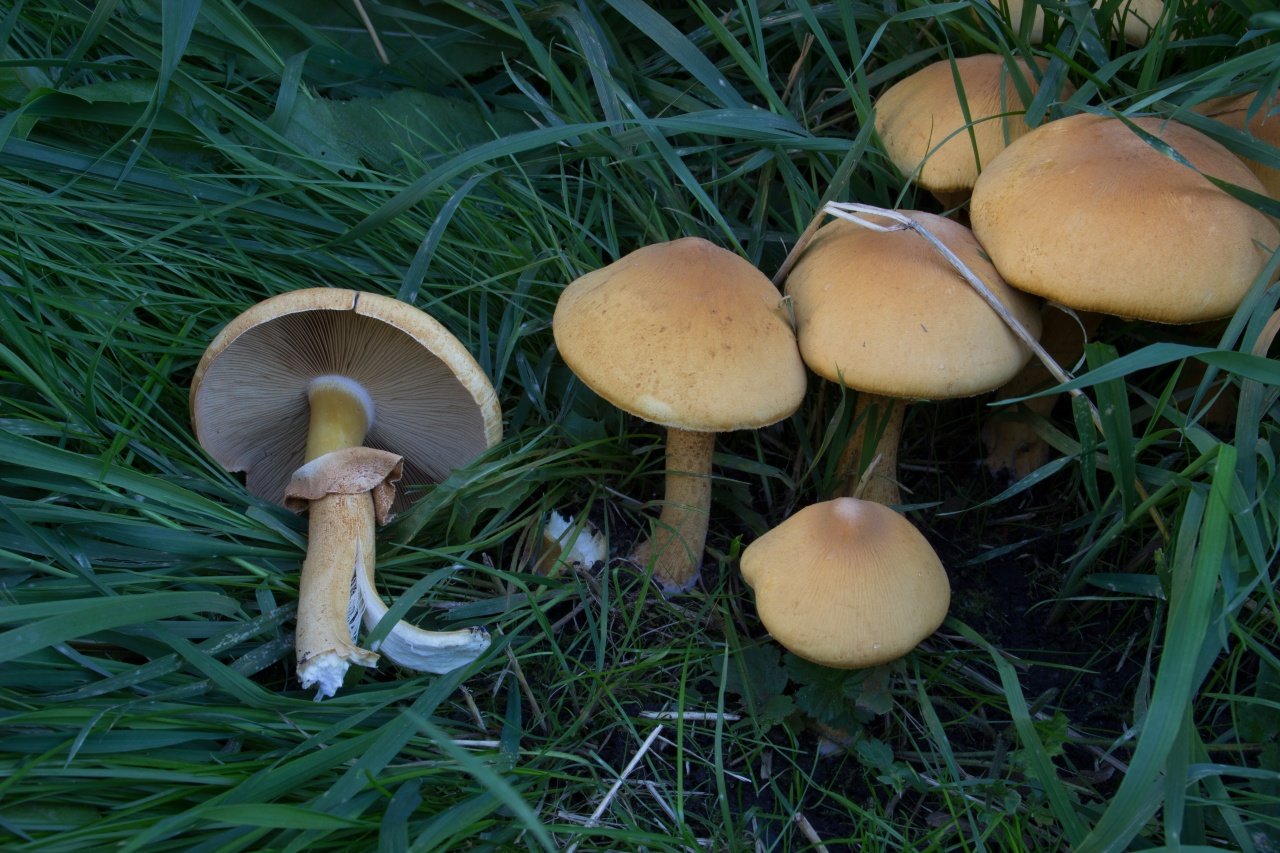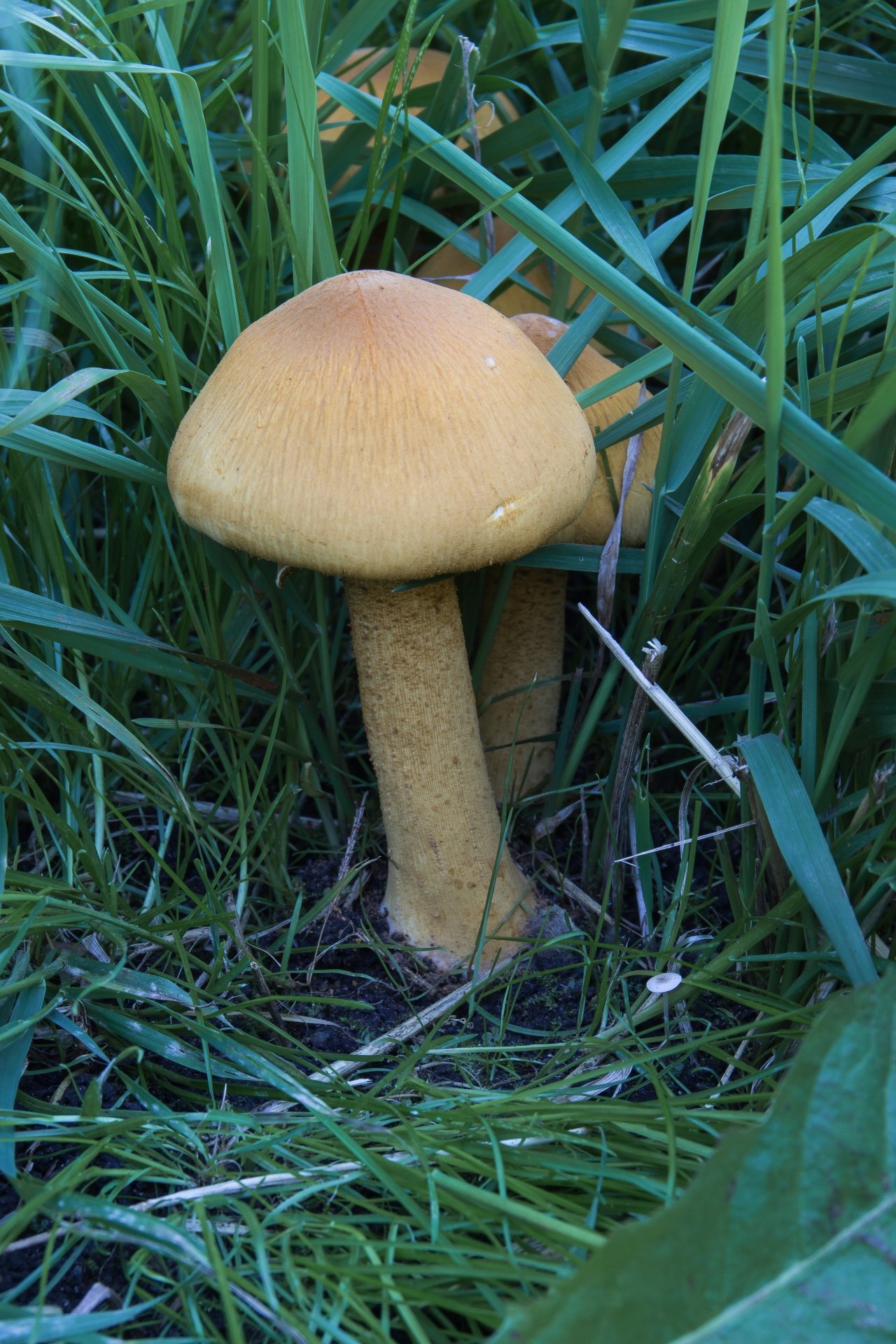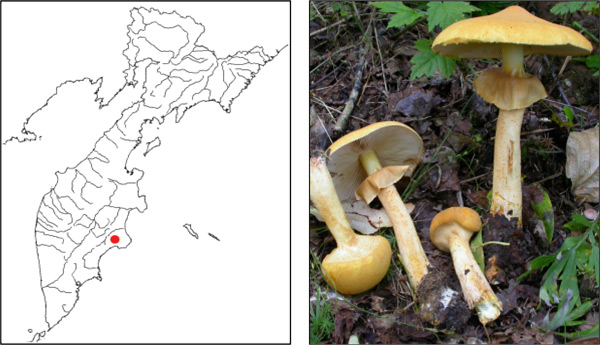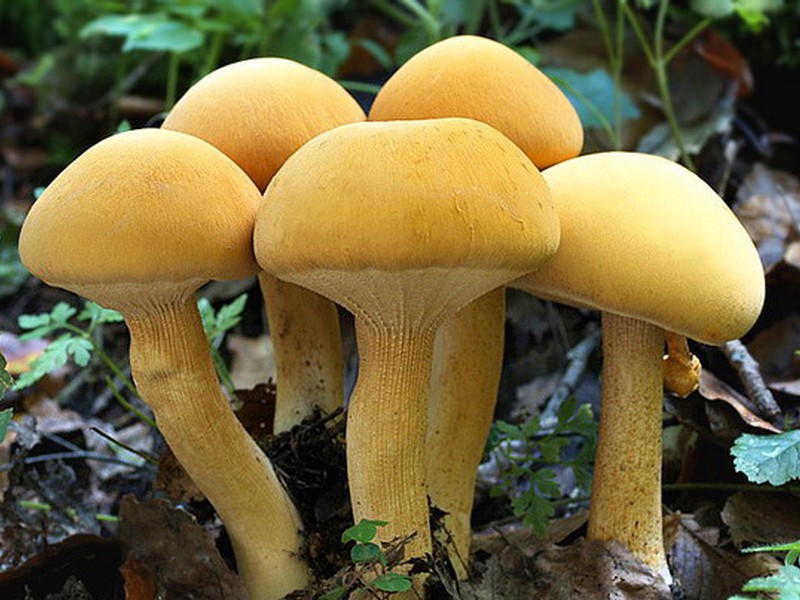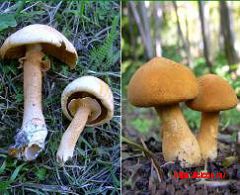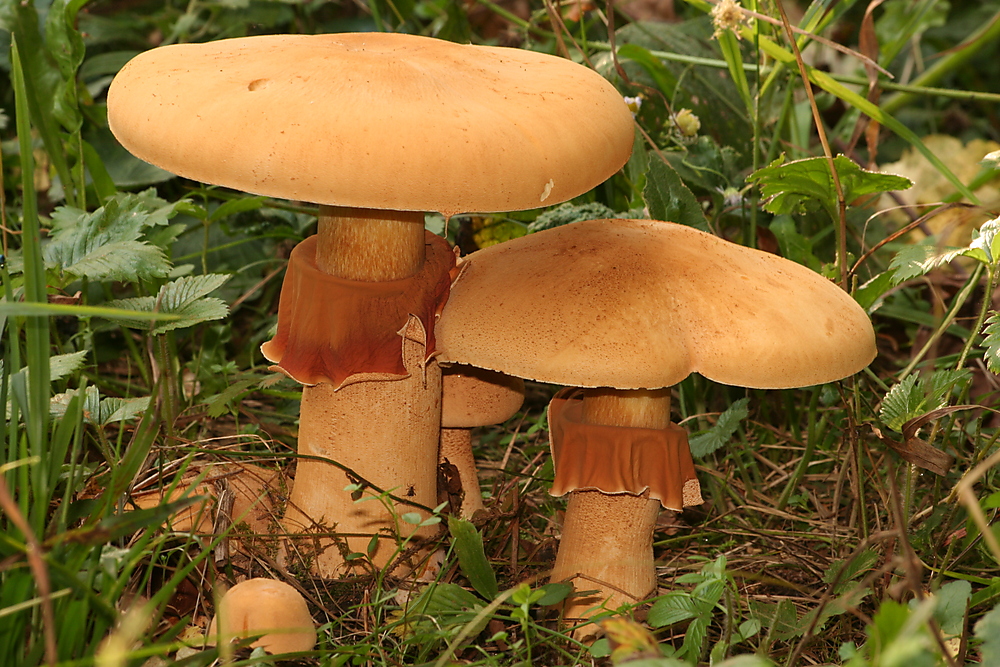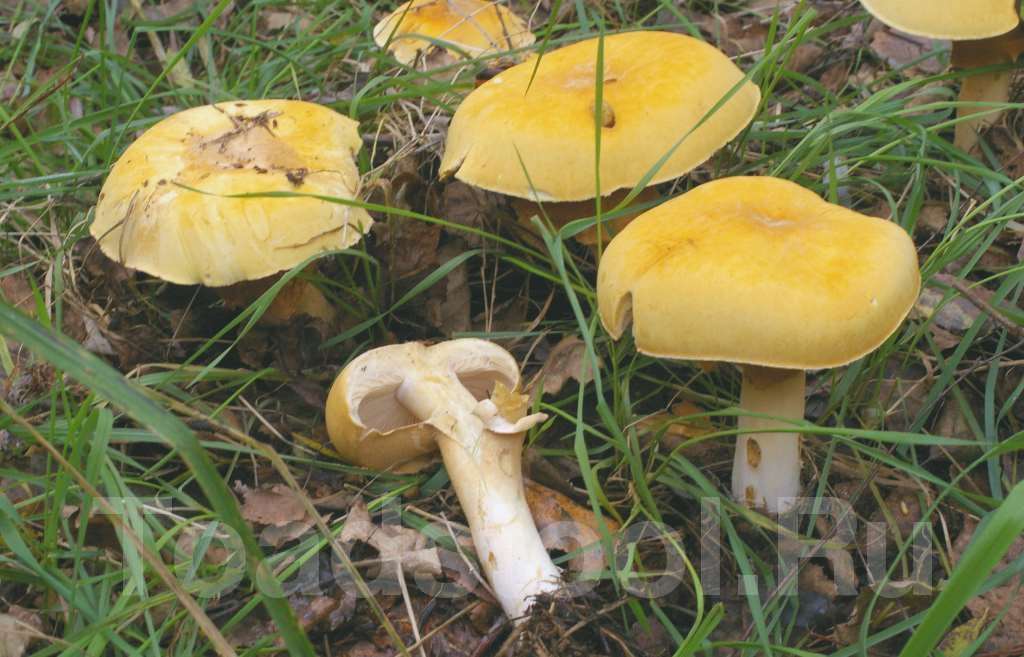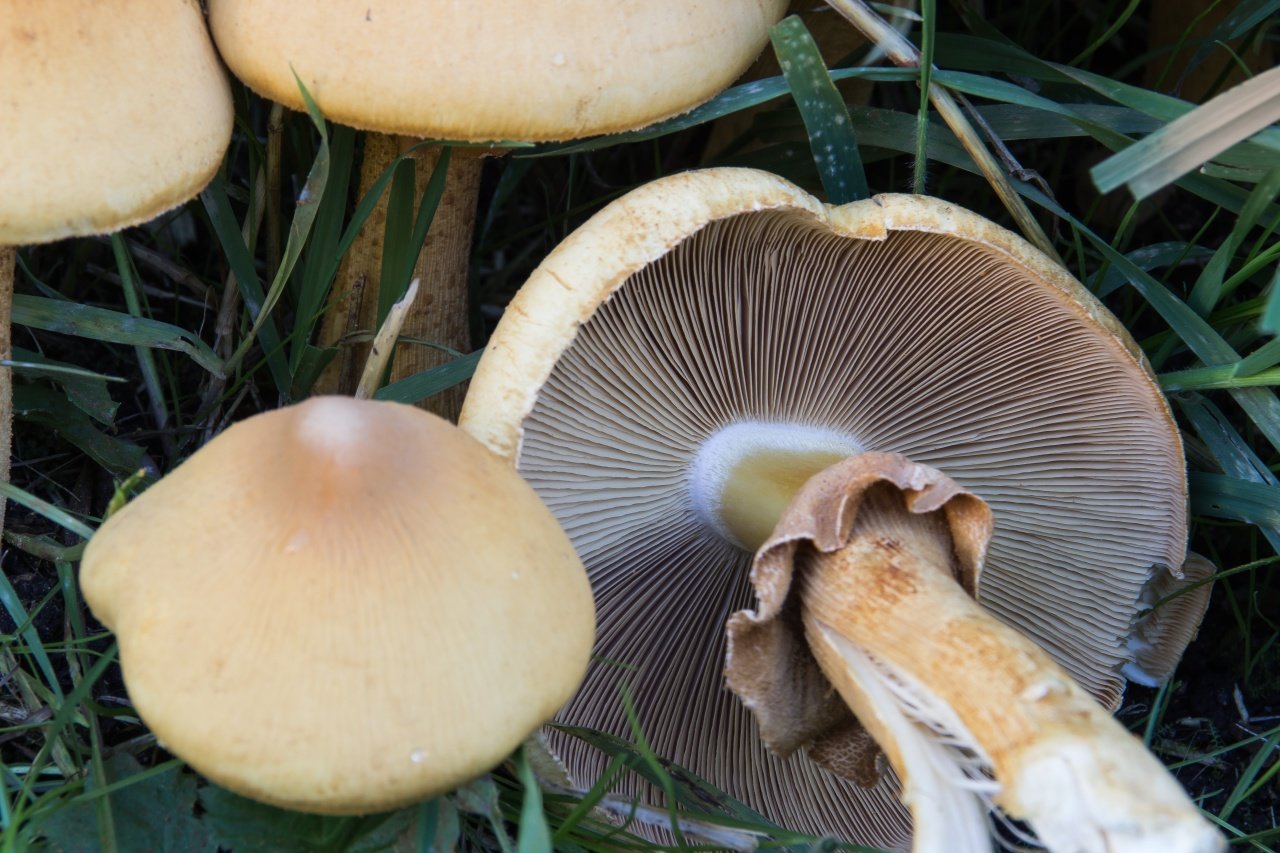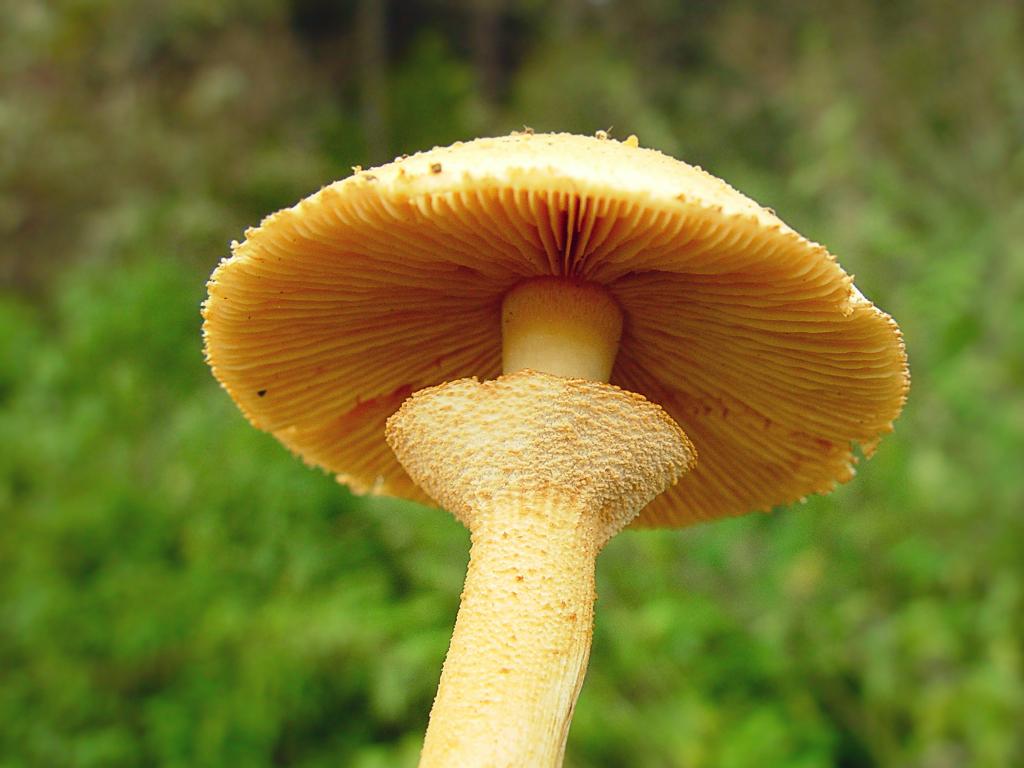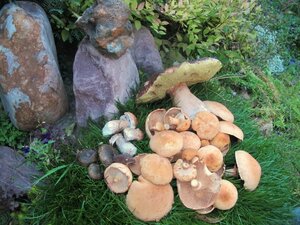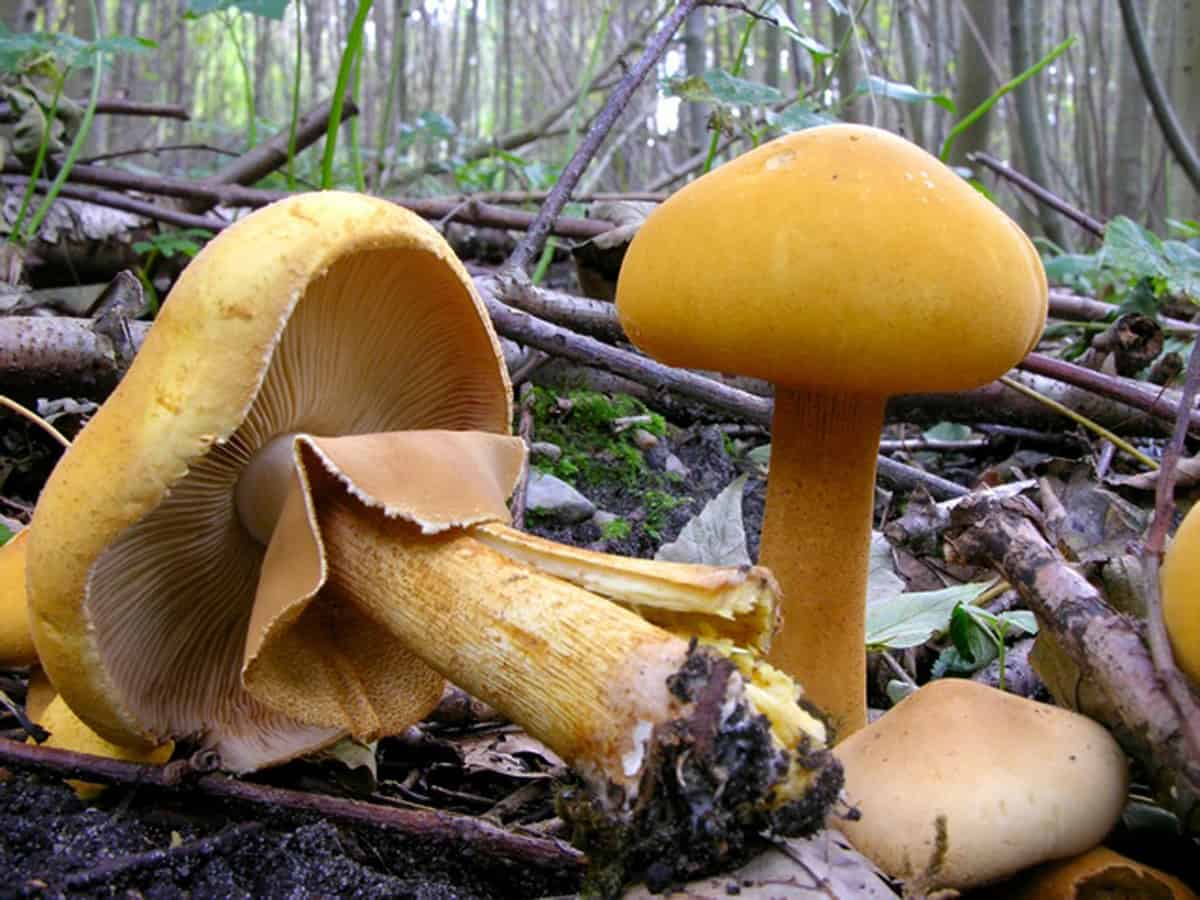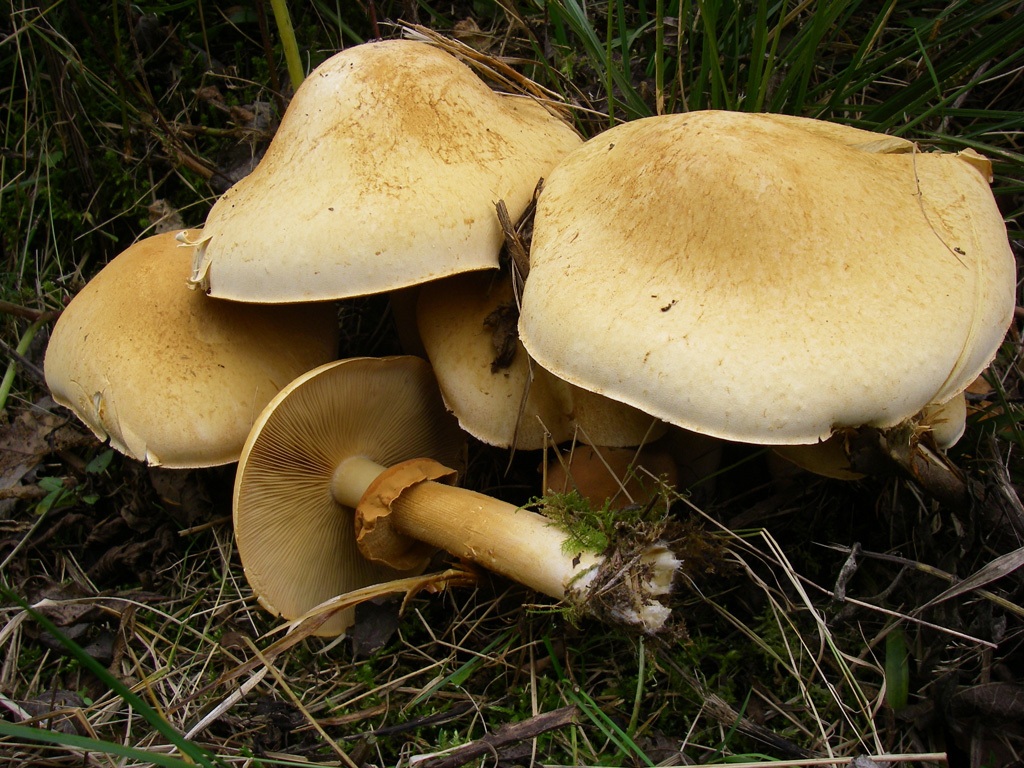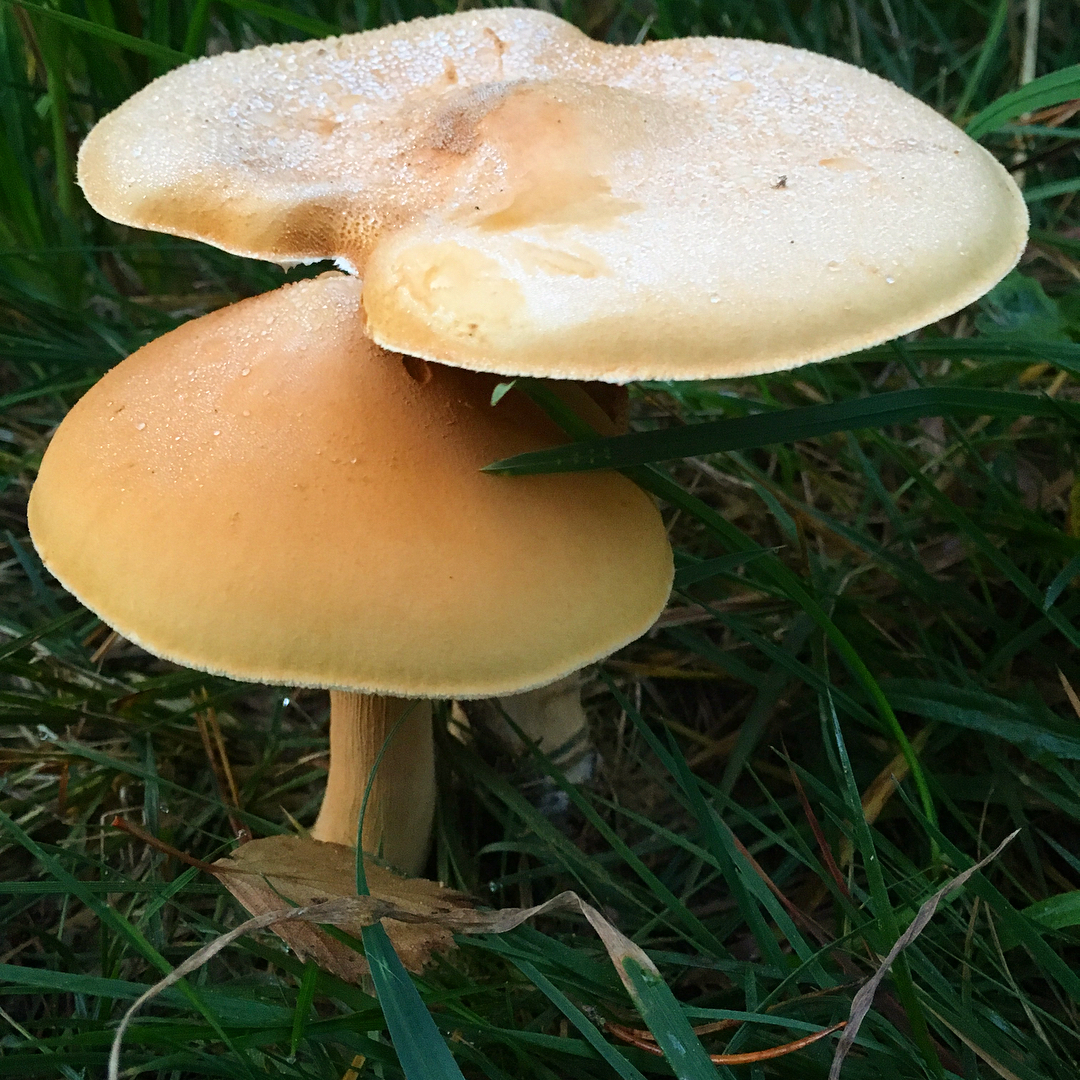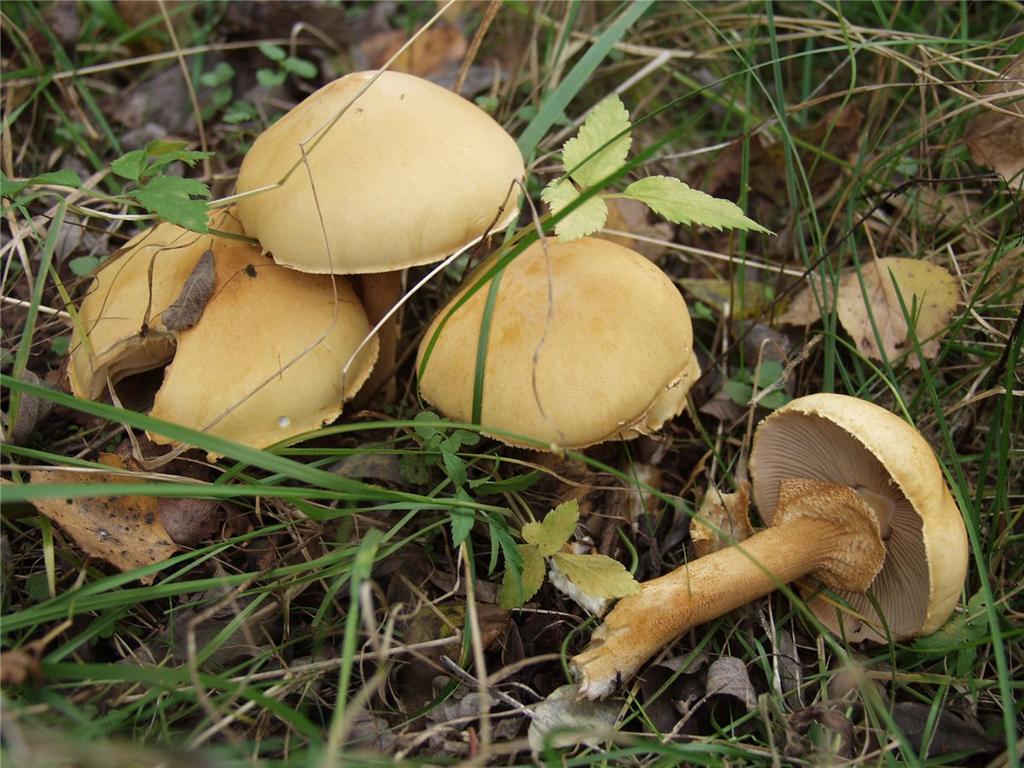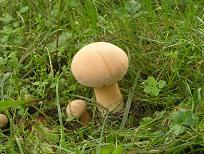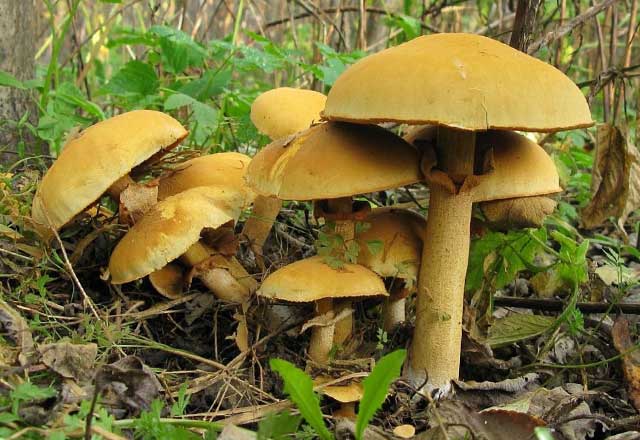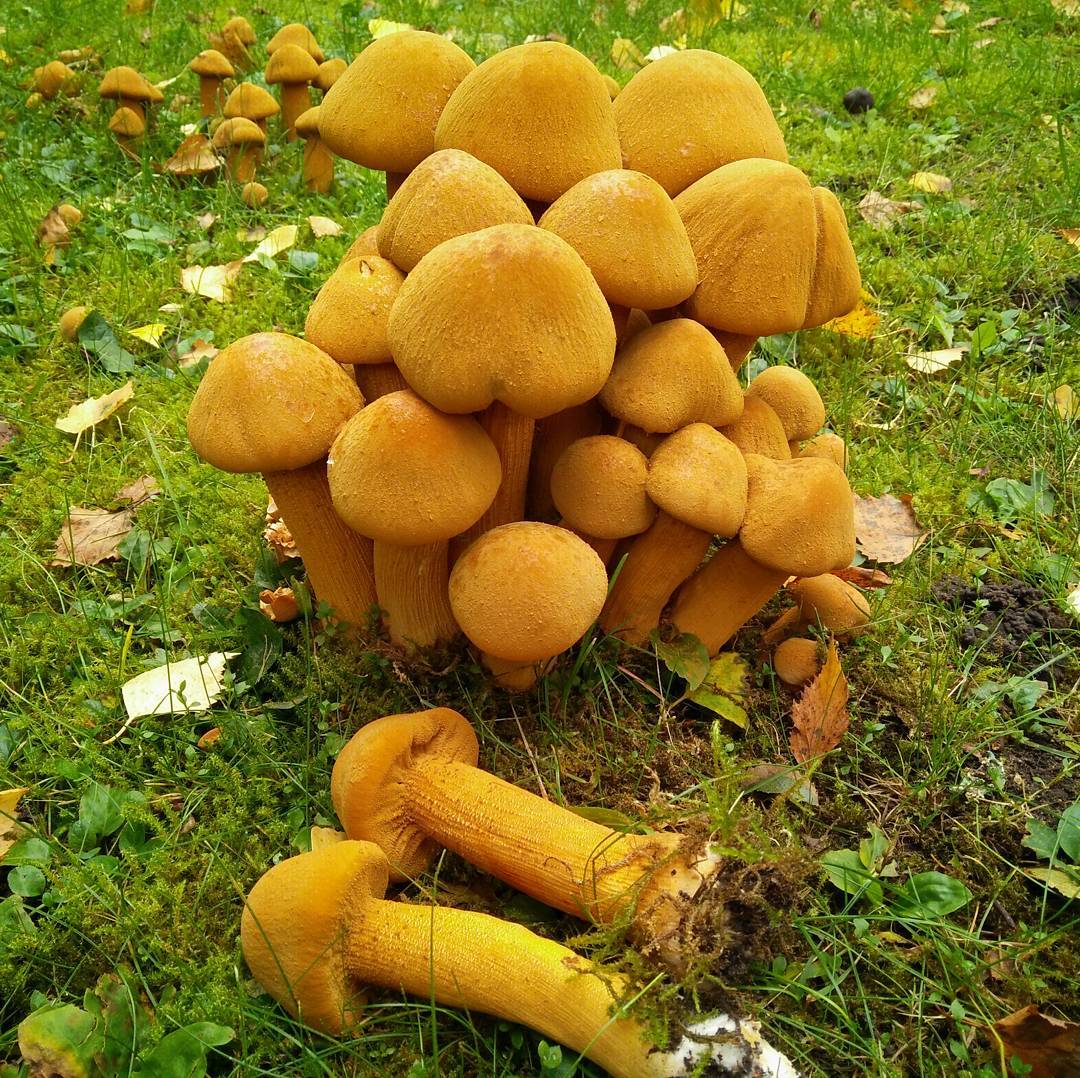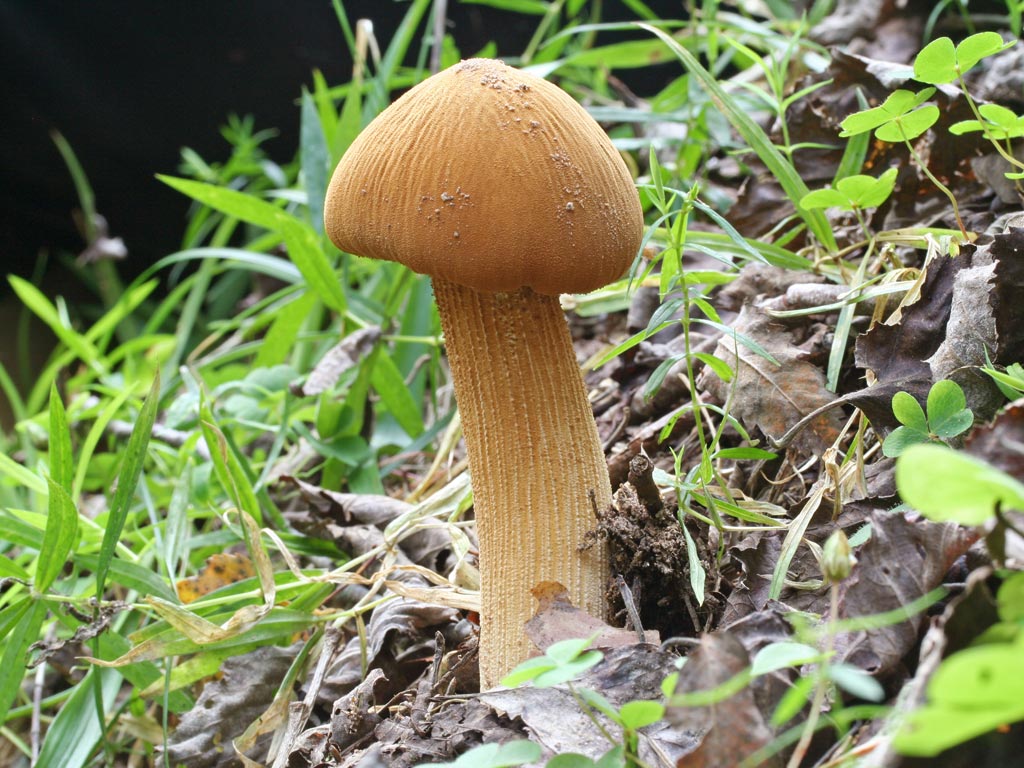Mustard mushroom (Theolepiota golden): description and photo
| Name: | Mustard plaster |
| Latin name: | Phaeolepiota aurea |
| Type of: | Inedible |
| Synonyms: | Umbrella golden, Mustard plaster, Herbal scales |
| Systematics: |
|
Pheolepiota golden (phaeolepiota aurea) has several other names:
- mustard plaster;
- herbaceous scaly;
- golden umbrella.
This forest dweller belongs to the Champignon family. The mushroom has its own characteristic appearance, it is difficult to confuse it with others. This forest representative is considered an inedible specimen.
The mustard plaster mushroom in the meadow has a rather attractive appearance.
What does the golden pheolepiota look like?
The young representative of this species has a hemispherical cap ranging in size from 5 to 25 cm, matte yellow-golden, yellow-ocher, sometimes orange. As the fungus grows, a tubercle (mound) appears in the center of the cap and resembles a bell in appearance. The surface looks grainy. In a mature mushroom, this sign becomes less and may disappear altogether. Frequent, curved, thin plates are located inside the hat umbrella. They grow to the fruiting body. While the mushroom is young, the plates are covered with a dense blanket. On the edge, at the place of its attachment, a dark stripe sometimes appears. The color of the bedspread does not differ from the color of the cap, although in some cases it can have a shade either darker or lighter. As they grow, the plates change their color from pale yellow, whitish to brown, even rusty. Spores have an oblong, pointed shape. The color of the spore powder is brown-rusty. After the maturation of the spores, the plates darken.
The leg of the representative of the species is straight, it can be thickened towards the bottom. Height is from 5 to 25 cm. The surface of the leg, like the caps, is matte, grainy. While the specimen is young, the stem of the stem smoothly turns into a private veil. The color of the trunk does not differ and has a yellow-golden color. As the mushroom body grows, a wide hanging ring of the same color, possibly slightly darker, remains from the coverlet. Above the ring, the stem of the peduncle is smooth, similar in color to the plates, sometimes with whitish or yellowish flakes. In older specimens, the ring decreases. The leg becomes dark over time and takes on a rusty brown tint.

Hanging wide ring on the leg after tearing the bedspread
The flesh of this forest representative is fleshy, thick, sinewy. Its color differs depending on the location: in the cap, the flesh is yellowish or white, and in the leg it is reddish. It does not have a very pronounced odor.
Where does the mushroom grow golden umbrella
This type of mustard plaster is common in Western Siberia, Primorye, as well as in European Russian districts.
The mustard plaster is found in small or large groups. Grows in places like this:
- roadside or ditch;
- fertile fields, meadows and pastures;
- shrubs;
- nettle thickets;
- forest glades.
Is it possible to eat the mushroom Pheolepiota golden
Felepiota golden raises concerns about edibility. Previously, the umbrella was ranked as conditionally edible mushrooms, but it was advised to eat it only after the obligatory heat treatment for 20 minutes. At the moment, according to some scientists, the mushroom is classified as an inedible species.
Conclusion
Felepiota golden belongs to the Champignon family. Has its own characteristic appearance and attractive color. It grows in groups, mainly in open, light areas in Western Siberia, Primorye, as well as in European Russian districts. It is considered inedible.
Is it good for cooking and can there be poisoning?
Theolepiota was initially considered conditionally edible, since it has not been sufficiently studied.
However, in Swiss books it is presented as a delicious and edible mushroom. It has a pleasant taste, reminiscent of champignons, but should be boiled for 20 minutes before use.
American and Canadian researchers think otherwise, as there have been cases of indigestion, diarrhea and abdominal pain. This is due to the cyanides and hydrocyanic acid contained in the pulp. But the latter is also present in edible fruit pits. That is, in small doses, it is not toxic and cannot cause significant harm to health.
Characteristics of the fungus herbal flake
Hat
- Advertising -
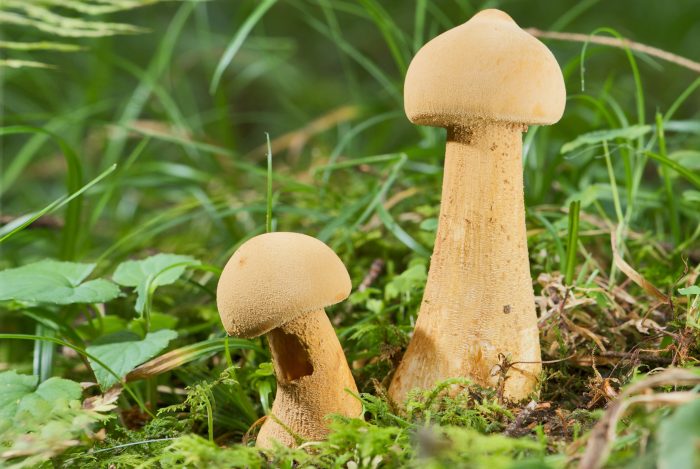
The cap reaches 5-25 cm in diameter, the shape is flat-convex, the surface is smooth or finely scaly, golden yellow, sometimes with an orange-red tint, dark in the center.

The flesh of the mushroom is thick, fleshy, white or yellowish, reddish in the stem, the smell and taste are weak.
Leg
- Advertising -

The height of the leg is 6-25 cm, diameter is 1-5 cm, the shape is cylindrical, in the middle with a swelling, the color is the same as the cap or light brown. There is a ring on the leg, the surface above which is flakes, and below the ring is smooth. The ring is wide, filmy, covered with a rusty bloom and stripes.
Rules for harvesting golden currants
Gathering season
It is necessary to collect golden currant berries as they ripen, usually in the middle of summer. Harvesting is best done in dry weather, early in the morning.
Harvesting and drying

It is recommended to put the fruits of this shrub in a solid container so that they do not crack and do not let out the juice. You need to immediately set them aside in a cool place, in the shade. Before drying or using for medicinal purposes, the long mustache at the end of the berry should be carefully trimmed.
Storage rules
Fresh berries of golden currants are stored for only a few days, so it is recommended to either dry them or sugar.
Description of pheolepiota golden
At a young age, her cap is hemispherical, later becomes convex-prostrate, and a small tubercle remains in its center. Its diameter is 5-25 centimeters. The color of the cap is ocher-yellow, golden-yellow, ocher, sometimes with an orange tint. The surface of the cap is grainy, matte.

On the edges of the cap of mature specimens, there may be fringed remains of the bedspread. In young specimens, the granularity of the cap is more pronounced, but gradually it decreases and may disappear altogether. Also, in young mushrooms, a dark stripe may be noticeable along the edge of the cap at the point of attachment of the frequent bedspread.
On the inner side of the cap are convex, thin plates. They grow to the fruiting body. The color of the plates can be white, yellow, light clay, light ocher, and in mature specimens the plates become rusty brown. At a young age, the plates are covered with a membranous dense blanket. The color of the bedspread matches the color of the cap, but sometimes its shade can be slightly darker or, conversely, lighter. The spores are pointed, oblong. The color of the spore powder is rusty brown.

The leg is straight, with a slight thickening at the base, sometimes widened in the middle. Its height is 5-20 centimeters, sometimes it reaches 20 centimeters. The surface of the leg is matte, grainy, longitudinally wrinkled. In young mushrooms, the leg smoothly turns into a private veil. At a young age, the granularity of the leg is very well expressed, up to the scales.
The color of the leg is the same as that of the bedspread. When the coverlet breaks, a wide, hanging ring remains on the stem. There are brown scales on the ring. In old mushrooms, the rings are noticeably reduced in size. Above the ring, the surface of the leg is smooth, the same color as the plates, sometimes there are yellowish or whitish flakes on it. When the spores mature, the plates darken, but the stem remains light. But over time, the leg also darkens, and its color becomes rusty brown.

Areas of growth of golden pheolepiota
Fruiting of mustard plasters occurs from July to October. They meet in large groups.Theolepiota golden prefers to settle on fertile rich soils, for example, in pastures, meadows, fields. Also, these mushrooms grow along roads, next to bushes and nettles. In addition, they can grow in bright clearings of deciduous forests.

Despite the fact that golden pheolepiota bears fruit in large groups, it is considered a rare species and is in the Red Data Books of many regions of the Russian Federation.
Theolepiota golden (Mustard mushroom): what it looks like, where it grows, edible or not
Theolepiota golden, or golden umbrella, or mustard plaster
A hat with a diameter of 4-12 cm, sometimes up to 20 cm, at first hemispherical or conical, with a dense gray-ocher private veil, then convexly - prostrate, with a small tubercle, sometimes with a lowered edge, matte, granular, sometimes with whitish remnants of the veil along the edge, bright , golden yellow or ocher yellow, ocher, with an orange tint, with a darker middle
The pulp is thick, fleshy, white or yellowish, in the leg it is reddish, without a special smell.
Plates are frequent, thin, adherent, at first covered with a gray-yellow or ocher private membranous veil, pale ocher, yellowish, then ocher-brownish, rusty.
The leg is on average 6-10 cm long and 1-3 cm thick, widened towards the base or swollen in the middle, above the ring under the plates with small white flakes, below the ring - matte, grainy, one-color with a cap, yellow-ocher, grayish-yellowish , sometimes with weak longitudinal wrinkles. The ring is curved, wide, filmy, whitish above with a rusty bloom, radially wrinkled below, with a powdery ocher bloom.
It grows both in groups and singly, from August to October in rare deciduous and coniferous forests and parks, in glades and open places, on the sides of roads and clearings, in grass, nettles, in bushes, prefers rich soil.
The mushroom is edible. tasty, but rare and poorly studied.
Who would have thought that this rather rare, edible mushroom would become almost a disaster at my dacha. Five years have passed since the mushrooms appeared on my site. In the second year, the harvest was three buckets. On the third ten. On the fourth, the number of mushrooms became threatening and had to be fought with them.
In the last season, the mushroom invasion has subsided. Hat:
the mushroom has a golden yellow color, at first spherical, then prostrate, with a noticeable central tubercle, convex, with a fringed edge and a granular surface, usually from 10 to 25 cm in diameter. - the mushroom is rather large. In young specimens, the cap is connected to the stem by a very dense private veil. The color of the cap varies from apricot to ocher yellow with a golden sheen.Pulp: very dense, initially white, turns yellow over time, and in the tuberous base it becomes reddish-brown, has a faint fruity odor and almond taste. The plates are adherent, frequent, at first pure white, then acquire a reddish or yellowish brown tint.Leg: fusiform, solid, from 10 to 30 cm in height, 1.5 to 4 cm thick, lighter above the ring and slightly thickened at the base, with a dense shell covering at least two-thirds of its height. In the upper part, this shell expands, acquiring an ocher color with a noticeable red tint when spores hit it. Spore powder, ocher brown.
In the literature and on the Internet, little is said about this mushroom, I will give the most interesting excerpts. Phaeolepiota aurea: A beautiful, mysterious mushroom This is a rare, beautiful and almost golden luminescent mushroom. These mushrooms have never been seen in large numbers on either side of the Atlantic. This mushroom was presented at the exhibition "Mushrooms 2000" organized by Societe Mycologique La Riviera, in the city of Vevey, located on the shores of Lake Geneva in Switzerland. The fungus was found along the way, at a site called Les Paccots, in Canton Friborg, where it grew in a large magic ring among nettles. Many professional mushroom pickers and experienced amateurs admitted that they had never met this mushroom.In 45 years of mushroom activity, we saw these mushrooms on our own only once in the Netherlands, in 1975, where we found them near the town of Utrecht, on the slope of a dam, among nettles under old bushes. Identifying the mushroom at that time was not easy because this interesting mushroom was not mentioned in the available Dutch and German literature. However, the Dutch organization Svampeflora by Morton Lang Illustreret provided us with a description and illustration that matched Phaeolepiota aurea. Later we found a description of Phaeolepiota aurea in 30 of 80 books. The mushroom is most often mentioned in Canadian and American literature. Analysis of the oldest books revealed a great deal of confusion between P. aurea and Gymnopilus spectabilis, which differs from Phaeolepiota in that it grows on large stumps and has a very pungent taste. For example, in Flore des champignons superieurs France (1909), Bigeard and Guillemin described Pholiota aurea as growing in clusters at the base of trees on sandy soils. The same mistake was made by Costatin and Dufour in La nouvelle flore des champignons (1912); they also reported a very pungent taste.
Theolepiota golden: description of the species and where it grows, photo
Theolepiota golden, herbal flake
(lat.Phaeolepiota aurea ) - a mushroom from the familySpiderweb (according to other sources -Champignon orOrdinary ), a representative of a monotypic genus.
The hat is 5-25 cm in diameter and ranges in color from pale to bright orange and ocher. The leg is 6-25 cm high, 1-5 cm thick. The cap and leg are covered with scales. On the cap, it is expressed only in young fruiting bodies, on the stalk and on the veil, on the contrary, it is very characteristic and gives the fruiting body a golden hue, which gave the name to the species. The pulp is white, the plates are light brown with smooth edges. Spores are oblong, pointed, coarse, 10-14 × 5-6 microns in diameter.
The fungus is common in North America and Eurasia. Occurs in used meadows and pastures, along roads, often near nettles. ... Fruiting bodies usually appear in large groups in late summer and autumn.
Various cookbooks recommend pheolepiota for its excellent taste, but recent research has shown that fruiting bodies contain traces of toxic hydrocyanic acid, so the mushroom is no longer considered edible. Heat treatment reduces its concentration, which is why the mushroom was considered edible for a long time.
Synonyms
List of scientific synonyms:
- Agaricus aureus Matt., Résult. Voy. Belgica, Lich .: 331 (1777)
- Agaricus aureus var.herefordensis Renny, Handbook of British Fungi, 2nd Edn: 140 (1883)
- Agaricus aureus var.vahlii (Schumach.) Cooke, Handbook of British Fungi, 2nd Edn: 140 (1884)
- Agaricus spectabilis Fr., Elench. fung. (Greifswald) 1:28 (1828)
- Agaricus vahlii Schumach., Enum. pl. (Kjbenhavn) 2: 258 (1803)
- Cystoderma aureum (Matt.) Kühner & Romagn., Fl. Analyt. Champ. Supér. (Paris): 393 (1953)
- Fulv>
Young fruiting bodies: one in section
The bedspread is still closed
2 days later: both the veil opened
Notes (edit)
- ↑Phillips R Mushrooms and Other Fungi of North America - Firefly Books, 2005 .-- P. 320 .-- ISBN 1554071151.
- ↑ CABI Bioscience Databases
Wikimedia Foundation. 2010.
An excerpt characterizing Theolepiot
- Ouch! - Stella laughed with a bell. - Well, what are you! .. Stop it! - Stop being sad! - I did not give up. - We wondered how much more we need to do, and you are limp. Well, let's go to arrange for the children! .. And then, quite unexpectedly, Arno appeared again. We stared at him in surprise ... afraid to ask. I even had time to think - did something terrible happen again? .. But he looked "extremely happy", so I immediately dropped the stupid thought. - And what are you doing here ?! .. - Stella was sincerely surprised. - Have you forgotten - I have to pick up the kids, I promised them. - And where is Michelle? Are you not together? - Why not together? Together, of course! I just promised ... And she always loved children. So we decided to stay together until a new life takes them away. - So this is wonderful! - Stella was delighted. And then she jumped to another. - You're very happy, aren't you? Well, tell me, are you happy? She's so beautiful !!! .. Arno looked into our eyes for a long time and attentively, as if wishing, but not daring to say anything. Then, finally, I made up my mind ... - I cannot accept this happiness from you ... It is not mine ... This is wrong ... I am not worthy of it yet. - How can you not ?! .. - Stella literally soared. - How can you not - still how can you! .. Just try to refuse !!! Just look how beautiful she is! And you say - you can't ... Arno smiled sadly, looking at the raging Stella. Then he embraced her affectionately and quietly, quietly said: “You’ve brought me untold happiness, and I’ve brought you such terrible pain ... Forgive me dear ones, if you ever can. Forgive me ... Stella smiled at him lightly and affectionately, as if wishing to show that she perfectly understands everything, and that she forgives him everything, and that it was not his fault at all.Arno just nodded sadly and, pointing at the quietly waiting children, asked: - Can I take them "upstairs", what do you think? - Unfortunately - no, - Stella answered sadly. “They can't go there, they stay here. - Then we, too, will stay ... - a gentle voice sounded. - We will stay with them. We turned around in surprise - it was Michelle. “That’s all decided,” I thought enough. And again, someone voluntarily sacrificed something, and again simple human good won out ... I looked at Stella - the baby was smiling. Everything was fine again. - Well, will you walk with me a little more? Stella asked hopefully. I had to go home for a long time, but I knew that I would never leave her now and nodded my head in the affirmative ... To be honest, I didn't have too much mood to walk, because after all that happened, the state was, let's say, very and very "satisfactory ... But I also could not leave Stella alone, therefore, so that both of them feel good at least" in the middle ", we decided not to go far, but just to relax a little our, almost boiling, brains, and to give rest to the exhausted pain hearts, enjoying the peace and quiet of the mental floor ...
Flame and early scales

Fire scale is an inedible lamellar mushroom that grows in groups from mid-July to late September.
The peak of fruiting is observed in August-September. Most often found on stumps and coniferous wood.
The cap of the mushroom is at first hemispherical, and then convex-outstretched, with a diameter of about 10 cm. Its surface is dry and contains concentric zones composed of small scales. Colored bright yellow. The plates are narrow, adherent, first bright yellow, and then brown.
The leg is rounded, solid inside, about 8 cm high and about 1 cm in diameter. Above it is smooth, and below it is scaly. It is painted orange-yellow at the cap, and rusty closer to the base. The peduncle has a characteristic scaly ring. The flesh is thin, tender, soft in the cap, hard in the stem, yellow in color, with an unpleasant herring smell.
Flame scales are not dangerous to human health, but due to their low taste and unpleasant odor, they are not used for food.
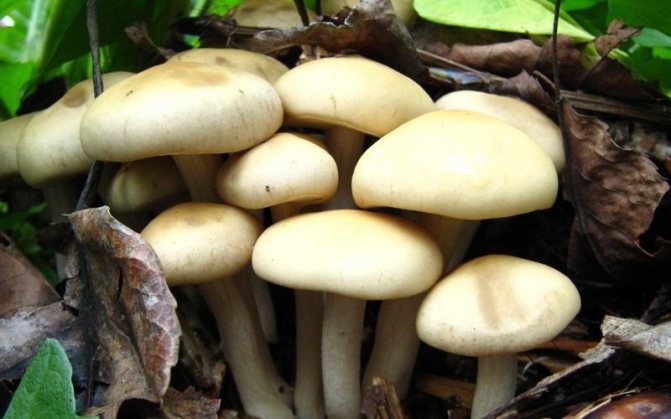
Early scaly, or early agrocybe, is a rare conditionally edible lamellar mushroom that grows in groups from late May to mid-June. Places of distribution - forest edges, parks, vegetable gardens, rare shrubs, roadsides.
The cap of the mushroom is hemispherical, over time it becomes convex-outstretched with a small tubercle in the middle. Its diameter is about 8 cm. The surface of the cap is matte, dry, dirty yellow. By the end of the season, it burns out and becomes faded. Plates are frequent, adherent, white in young mushrooms, brownish-olive in mature ones. The leg is rounded, hollow inside, about 8 cm high and about 1 cm in diameter. Its surface is smooth, dry, dull, white pubescent at the base, painted white, which acquires a brownish tint in the lower part. The peduncle has a characteristic filmy ring. The pulp is thin, dense, white, with a pleasant mushroom aroma.
Early flakes are eaten after preliminary soaking or boiling. It can be fried and marinated.
Time, places of fruiting, as well as measures for protecting the fungus in nature
Mustard plasters begin to grow from mid-July. Fruiting from August to September. In unfavorable years, there are few of them.
The plant is quite rare, it is difficult to find its habitat. Scales appear in nettles, small shrubs, in the grass on pastures, in city parks, in woodlands, on paths at the edge of the meadow. Among the grass in mixed forests, where trees grow densely, it is less common. They feel comfortable in abandoned fields. In the case when the soil and the place is suitable for growth and there is enough area for the mycelium, they bear fruit annually.
Distributed in Asia, Western and Eastern Europe, North America, Russia in the Far East and the Caucasus.
The nature reserves observe the protection regime for the rare fungus. Aureum Cystoderma is listed in the Red Book of Russian Regions.
How to distinguish false counterparts of an inedible mushroom
If there is even a little experience, then it is impossible to confuse Theolepiota. But those with a developed imagination are able to see something different in Togaria aurea.
Similar species:
-
Junonius gymnopilus is a spiderweb mushroom. Clumps in the trees. It is similar in shade and general appearance, but does not have a “cover” on the leg, ending in a skirt, and “powder”. Taxonomists have confused them for a long time. Called Gymnopilus spectabilis, squeezed into varieties or declared synonyms. In fact, the types are different.
Junonius gymnopilus
-
Fallax cystoderma - common. Similar colors and powder. Twins grow on needles, rotten stumps and moss.
Fallax cystoderma
Botanical description of flake species
The most popular and widespread species on the territory of the CIS countries are edible flakes, golden, common, cinder, and alder. Each of the presented species has individual characteristics, thanks to which they cannot be confused with other mushrooms.
Edible flakes
Edible flake has other names - hint, hint, hint foliot. The fruiting body consists of a thin low stem and a small rounded orange cap. Its surface is covered with mucus.
It grows both in the wild and under artificial conditions. It is widely used in Japanese cuisine.
Scale golden
This type of mushroom has a large cap 20 centimeters in diameter, which in young fruits has a slightly curved edge. It has a tubercle in the center. Dense in structure, the color can vary from yellow to reddish or brown. At high air humidity, the cap becomes slimy, and in dry weather it dries up and has a shiny surface.
Ripe fruits have a yellow pulp, dense in structure. The leg reaches 15 centimeters in height, dense.
Scale golden
Common scaly
Refers to conditionally edible mushrooms. It is the most widespread and popular type of mushroom among all scales. Cultivated successfully by Japanese farmers and grown for sale, grows wild in temperate climates.
For normal growth, it needs light, appears on the surface as soon as the snow melts. The season lasts until mid-autumn. Grows in rare forests with a large number of clearings (woodlands), as well as small parks. Distributed in Siberia, the Urals, Western and Eastern Europe.
Scaly fleecy
The fleecy scaly grows as a parasitic organism on dying tree trunks. It grows in small groups, and the fruiting season begins in mid-August and lasts until November. The hat is small - up to 10 centimeters in diameter, convex. The surface is covered with slightly protruding scales. The pulp is homogeneous, firm and tastes like a radish. The leg is long - it reaches 12 centimeters in height.
The mushroom belongs to the fourth category and is generally edible, but is not used in cooking due to its bitter taste.
Scaly fleecy
Poplar scale
Poplar flake has other synonyms - destructive, poplar. It parasitizes on stumps or dry tree trunks. Distributed in the European part of Russia, as well as in Siberia and the Primorsky Territory. The hat is 15 centimeters in diameter, has a brown color and is covered with white fibers. In mature fruits, they completely disappear. The leg is long.
It grows from the beginning of August to the end of September, prefers poplar, aspen, birch for growth. Inedible.
Flame scale
Fire scales have a cap diameter of about 10 centimeters, bright yellow or lemon color. In the center, the color is slightly darker, and along the edges there are large scales to match the fruit. The plates are brown, in young fruits they are covered with a small cobweb. The pulp has a pleasant aroma, slightly bitter.
It grows throughout the temperate zone of Russia at the base of deciduous trees, as well as stumps, moss.
Flame scale
Alder flakes
It grows in groups, adapting near the trunks of trees or stumps of alder, birch. The fruiting season begins in August and lasts until the end of September. The cap is small - about 5 centimeters in diameter, has brown scales with a yellow cap. The plates are beige with a yellow tint. The mushroom is inedible and can cause intoxication.
Cinder flakes
In young fruits, the cap has the shape of a hemisphere, and with ripening it opens slightly. In diameter it reaches from two to six centimeters, has a red-brown color. The surface of the fungus is slimy, with small fibrous scales.
The pulp is dense, light yellow. It has neither taste nor smell. The plates are frequent, adherent. The fruiting season starts in May and lasts until September. It grows mainly in places where fire is made.
Cinder flakes


